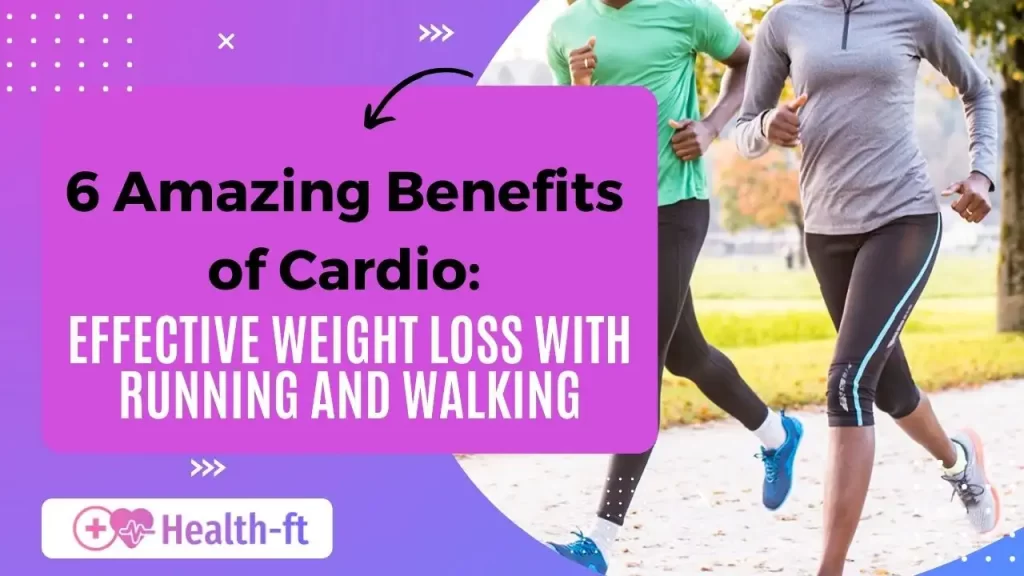The benefits of cardio are numerous, whether you choose to walk or jog. Both exercises improve cardiovascular health, enhance lung capacity, and support weight loss by burning calories. Walking is a low-impact activity suitable for beginners or those with joint concerns, while jogging offers a higher intensity for faster calorie burn and improved endurance. The effectiveness of each depends on your fitness goals and preferences, but both contribute significantly to overall health and wellness.
When incorporated into a weight training routine, HIIT exercixe can work wonders. In this piece, we will discuss the benefits of cardio, how walking and running measure up against each other when it comes to weight loss and if incline walking is actually a better alternative than running.
It does not matter if you are seasoned to running or exercising with a brisk walking program, making up your mind about either may be easier when you know how each one might help you achieve your fitness goals. Without further ado, let’s consider how both exercises may be of value to you!
What is Cardio?
Cardio, also known as aerobic exercise, includes all activities that cause the heart and lungs to function more effectively. Cardio benefits for weight loss may help maintain a healthy balance between consumed and burnt calories. More specifically, cardio for fat loss can assist in sounding fat loss by burning calories and increasing the body’s metabolism to encourage a balanced lifestyle. This includes but is not limited to running, biking, swimming, and even dancing.
What Are the Benefits of Cardio Workout?
Understanding cardio workout benefits highlights why this exercise is essential for overall well-being. Cardio exercises improve physical health and have significant mental health advantages, making them a key part of any fitness regimen. Here are some of the major benefits:
Improved Heart Health:
Recent research by the American Heart Association says that cardio can decrease your chances of getting heart disease, which is among the leading causes of death globally. Cardio exercise at gym or at home can improve the heart’s muscles so that they work more effectively at pumping blood and decreasing high blood pressure and cholesterol.
Weight Loss and Maintenance:
Since cardio is a fantastic calorie-burning exercise, it is one of the most effective activities for those aiming to shed extra pounds or maintain their weight. The benefits of cardio for weight loss are evident in its ability to create a consistent calorie deficit over time, which is essential for fat loss. Regularly incorporating cardio into your routine ensures sustained energy expenditure, leading to long-term weight management and improved body composition.
Mental Health:
Paying attention to your cardio also has the added advantage of improving mental health. The research conducted by Harvard Medical School established that cardio was effective in releasing feel-good hormones, notably endorphins that help to check anxiety and depression.
Increased Lung Capacity:
Aerobic exercise enhances lung function, improving the body’s ability to efficiently deliver oxygen, which boosts overall physical performance. A regular 30-minute cardiovascular workout can significantly increase lung capacity, helping you feel less fatigued during everyday activities like climbing stairs or carrying groceries. This improved endurance translates to better physical functionality and a more active lifestyle.
Boosts Metabolism:
Engaging in popular forms of cardio, such as cycling or jogging, significantly raises your metabolism. This means that even if you burn 300 calories during the workout, your body continues to burn additional calories afterward, even while at rest. This afterburn effect makes cardio an effective tool for enhancing metabolic efficiency and supporting long-term calorie expenditure.
Improves Sleep Quality:
A study by the National Sleep Foundation indicates that people who engage in regular cardio exercise have better sleep quality and less incidence of insomnia than other people. I agree that either walking or running during the day does pay off when it comes to night sleep, it will be more profound.
Based on the above discussed benefits Cardinal is very crucial in enhancing health both of the body and the mind. So, what is the difference between walking and running and how does all this compare to helping you reach your goals.
What Are the Best Forms of Cardio? [Walking vs Running]
Among cardio exercises, walking and running can be effective for those looking to get in shape, depending on their fitness level and goals. But which of them is more beneficial to you?
The Case For Walking
One commonly known exercise is walking, which is primarily recommended since it does not require much effort or money to practice. Some people even finds it as one of the best means of exercising because it is suitable for professions that require one to sit most of the time, or for those people who have joint problems, it’s ideal for beginners too. Fast walking is one of the best exercises since it aids in strengthening the muscles of the heart, relieves knee pain and thus helps in weight loss.
Low Impact:
Walking is a low-impact aerobic exercise less strenuous on the bones and joints than running. This makes it an ideal option for individuals new to exercise, dealing with arthritis, or experiencing joint pain. Unlike more rigorous forms of exercise, walking is gentle on the joints, making it suitable for those recovering from injuries or older adults looking for a safe and effective way to stay active. Incorporating a daily walk can be highly beneficial for overall health and wellness.
Versatile:
Walking is a highly versatile form of cardio that can be done virtually anywhere—around the neighborhood, on a treadmill, or through a park. Walking outdoors offers additional benefits, such as fresh air and exposure to nature, both of which have been shown to improve mood and overall well-being.
Sustainable:
Aerobic exercises like walking are highly sustainable, as they can be performed for extended periods without causing burnout or significant risk of injury. Walking is an ideal daily activity for those seeking long-term health benefits, offering a consistent and manageable way to stay active.
The Case for Running
As for running, this is a more vigorous type of exercise, which in many ways can produce quicker results insofar as the burning of calories and enhancing the heart’s performance is concerned. In turn, it is suitable for use by those who need to shed some pounds in record time or an athlete wanting to achieve their desired goals faster.
High-Calorie Burn:
It burns more calories in the shortest time than walking does. Thus, every person who wishes to shed some poundage within the shortest possible time should go jogging. For instance, you will have burned nearly double the energy required for a run than if you decided to take a 30-minute cardio walk.
Endurance Boosting:
Jogging has been found to facilitate the improvement of cardiovascular endurance to a greater extent than walking. During running the rate of work of the heart and lungs increases and therefore regular running results in an improved aerobic fitness and endurance.
Stronger Muscles:
Since running involves the entire body, especially lower body muscles including your legs, core and glutes, it makes you develop muscles as it tones your stamina. Lineaments such as running, which involves an explosive movement, are good in the development of tone of muscles.
Both walking and running can be very effective, however, the decision on which is better and is tailor made will, of course, depend on your fitness capability, and more importantly on your and your certain health constraints or objectives that you may or may not have in the future.
How to Incorporate Both Walking and Running into Your Routine
Here’s how you can do it:
Start Slow:
For beginners, it’s essential to ease into jogging by starting with walking at a comfortable pace and gradually increasing speed. Incorporate short running intervals to allow your body to adapt to the increased intensity without overstraining your muscles. For example, begin your warm-up with 5 minutes of walking, followed by 1 minute of jogging, and repeat this cycle. This approach helps prevent muscle damage and gives your body time to recover and build endurance.
Mix It Up:
Incorporate variety into your routine by alternating between walking and running throughout the week. For example, schedule walking sessions in the morning or evening, especially when you’re tired or experiencing mild soreness. Reserve running for mornings when you’re well-rested and energized. You can also add incline walking to your program to introduce a new challenge and engage different muscle groups.
Use HIIT:
When you’re jogging, introduce High-Intensity Interval Training (HIIT) as one of your practices while exercising. This type of training involves a change in sets between high and low works and is ideal for burning the fats while building muscles simultaneously.
Track Your Progress:
Record your exercise using a fitness tracker via a website or an application. This will help you stick to your exercise regimen as you monitor your progress with your fitness levels over time. Other things like heart rate, pace as well as distance lets you monitor and maximize on your workouts.
What Are the Benefits of Cardio in Overall Fitness?
The movements involved in walking and running certainly do qualify as cardiovascular activities, however, you really should not limit your training regime solely to those two if you want to get into good shape. Cardio is about enhancing your endurance and health of heart but strength and flexibility training are also essential for you.
Combining Cardio with Strength Training:
Cardio assists in weight loss the health of your heart and makes you lose weight by burning calories while your muscles are strengthened through strength training and it helps pump blood and gain muscle mass. If you’re new to strength training, finding the best weight to start lifting is crucial for building strength safely.
Cardiovascular system benefits from the rhythmic movement; secondly, muscles also get benefited since one exercises every part of the body by weight training or body weighing.
Improving Flexibility and Mobility:
The aerobic exercises such as yoga or pilates that help to enhance the flexibility add to the cardio workouts by minimizing the likelihood of an individual experiencing an injury. Loose muscularity makes it possible to have improved posture, less stiff muscles as well as fewer cases of cramps or strains.
Walking and running can be coupled with other exercise in such a way that there will be no boredom hence a good program for a long term health.
Conclusion
The benefits of cardio are extensive, making it an essential part of any fitness routine. Walking and running contribute to improved cardiovascular health, weight management, and mental well-being. Combining walking and running adds variety and balance to your routine, keeping you engaged and motivated.
Pairing cardio with strength training and flexibility exercises creates a well-rounded fitness program that supports overall health, enhances physical performance, and promotes sustainable, long-term results.




